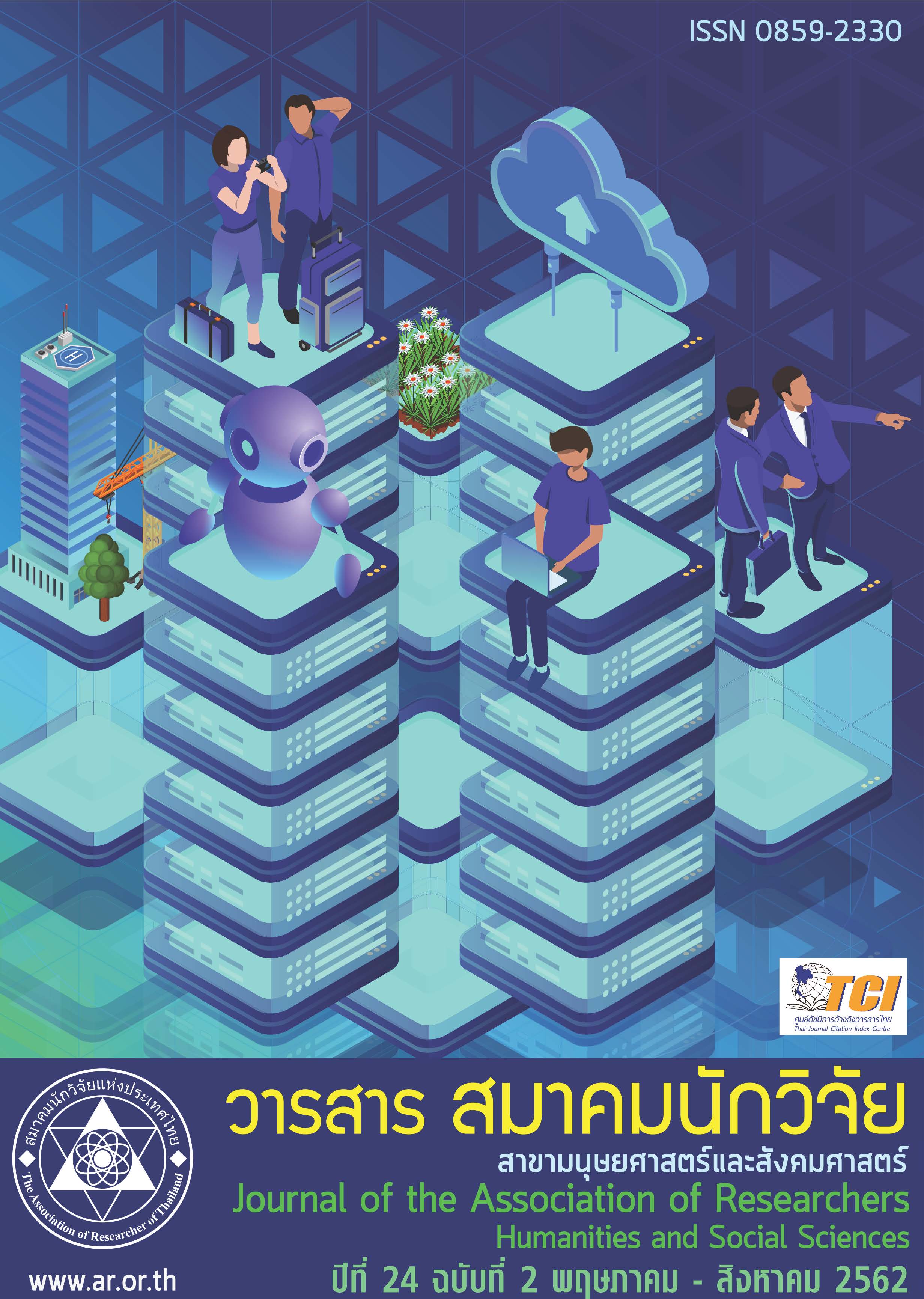Thailand 4.0 Floating Market Development Strategy for Sustainable Tourism
Main Article Content
Abstract
This research aims to 1. survey the Image of floating market in Thailand, traveler’s behavior, Thailand floating market strategy 4.0, and the development of sustainable floating market in Thailand 2. analyze the components of the four latent variables of the Image of floating market in Thailand, traveler’s behavior, Thailand floating market strategy 4.0, and the development of sustainable floating market in Thailand 3. analyze both direct and indirect effects of the Image of floating market in Thailand, traveler’s behavior, and Thailand Floating Market Strategy 4.0, those affect development of sustainable floating market in Thailand 4. find Thailand 4.0 floating market development strategy for tourism. This research integrated qualitative and quantitative research techniques. In-depth interview of travel marketing specialists were conducted to find the variables which were related to the achievement strategies and to develop a valid and reliable questionnaire, as an instrument to the quantitative research. The samples collected were 600. The data were analyzed by using descriptive statistics of percentage, mean and inferential statistics of Confirmatory Factor Analysis, Path Analysis and Structural Equation Modeling (SEM). The research revealed that: 1. the Image of floating market in Thailand, traveler’s behavior, Thailand floating market strategy 4.0, and development of sustainable floating market in Thailand were mostly at high level. 2. Confirmatory Factors Analysis implied that the Image of floating market in Thailand have the highest in the most impressive elements values, the traveler’s behavior factors was decision, Thailand floating market strategy 4.0 factors was place, the development of sustainable floating market in Thailand factors was Recommendation and referral. 3. the effect analysis found that the Image of floating market in Thailand and traveler’s behavior has direct and indirect influence on the development of sustainable floating market in Thailand 4. the constructed model corresponded with the empirical evidence of all variables (χ2 = 34.02, df = 32,χ2/df = 1.11, P = 0.37, RMSEA = 0.01)
Article Details
บทความที่ปรากฏในวารสารนี้ เป็นความรับผิดชอบของผู้เขียน ซึ่งสมาคมนักวิจัยไม่จำเป็นต้องเห็นด้วยเสมอไป การนำเสนอผลงานวิจัยและบทความในวารสารนี้ไปเผยแพร่สามารถกระทำได้ โดยระบุแหล่งอ้างอิงจาก "วารสารสมาคมนักวิจัย"
References
กัลยา วานิชย์บัญชา. (2552). สถิติสำหรับงานวิจัย. กรุงเทพฯ: ศูนย์หนังสือแห่งจุฬาลงกรณ์มหาวิทยาลัย
โกศล จิตวิรัตน์, นรพล จีนันท์เดช, ปิยะฉัตร จารุธีรศานต์ และอุไรวรรณ แย้มนิยม. (2556). การวิเคราะห์และนำเสนอผล การวิเคราะห์โมเดลสมการโครงสร้างพหุระดับ ด้วยโปรแกรม Mplus. วารสารสมาคมนักวิจัย. 18 (2). 70-83
สุภมาส อังศุโชติ, สมถวิล วิจิตรวรรณา, และรัชนีกูล ภิญโญภานุวัฒน์. (2552). สถิติวิเคราะห์สำหรับการวิจัยทาง สังคมศาสตร์และพฤติกรรมศาสตร์: เทคนิคการใช้โปรแกรม LISREL. (พิมพ์ครั้งที่ 3 ฉบับปรับปรุง). กรุงเทพฯ: มิสชั่น มีเดีย.
สาทิตร์ ม่วงหมี. (2556). รูปแบบการตลาดที่ยั่งยืนของธุรกิจขนาดย่อมตามหลักปรัชญาเศรษฐกิจพอเพียง. วารสารสมาคม นักวิจัย. 19 (1). 20-33
นวพร สังวร (2556). กลยุทธ์การสร้างความได้เปรียบทางการแข่งขันในการส่งออกยางพาราไทยส่งประชาคมเศรษฐกิจ อาเซียน. วารสารสมาคมนักวิจัย. 19 (1). 111-122
Angsuchot Supachamas, Vijittavanich Somtawin, and Gulipinyopanuvat Ratchanee. (2009). Analytical Statistics for Social Science Research and Behavioral Sciences: Techniques for Using LISREL Program (3th ed.). Bangkok: Mission Media.
Byon, K.K., Zhang, J.J. (2009). Development of a scale measuring destination image. Marketing Intelligence & planning, 28(4); 508-532.
Camprubi, R., Guia, J. and Comas, J. (2008). Destination networks and induced tourism image. Business Management & Product Design Department (OGEDP) at the Faculty of Tourism. 63(2); 47-58.
Chi, C. G.-Q., & Qu, H. (2008). Examining structural relationship of destination image, tourist satisfaction and destination loyalty: an integrated approach. Tourism Management, 29; 624–636
Chen, Y. & Xic, J. (2007). Cross-Market Network Effect with Asymmetric Customer Loyalty: Implication for Competition Advantage. Marketing Science. 26(1); 52-56.
Darnell, A. C., & Johnson, P. S. (2001). Repeat visits to attractions: a preliminary economic analysis. Tourism management, 22(2), 119-126.
Drucker Peter F. (2006). Classic drucker. Harvard Business School Press Practice.
Dmitrovic, T., Cvelbar, K. K., Kolar, T., Brencic, M. M., Ograjensek, I. and Zabkar, V. (2008). Conceptualizatiing tourist satisfaction at the destination level. International Journal of Culture, Tourism and Hospitality Research. Vol. 3. No. 2, pp. 116-126.
Hawkins, D. I., & Mothersbaugh, D. L. (2010). Consumer behavior: Building marketing strategy. Boston: McGraw-Hill Irwin.
Hu, L-T. & Bentler, P.M. (1999). Cutoff criteria for fit indexes in covariance structure analysis: Conventional criteria versus new alternatives. Structural equation modeling, 6(1); 1-55.
Jang, S., & Feng, R. (2007). Temporal destination revisit intention: The effects of novelty seeking and satisfaction. Tourism management. 28(2); 580-590.
Kandampully, J. & Hsin-Hui Hu (2007). The Influence of a Hotel Firm's Quality of Service and Image and its Effect on Tourism Customer Loyalty. International Journal of Hospitality & Tourism Administration. 2(1); 21-42 February 2011.
Kenneth & Donald. (2004). Marketing Management. New York: Prentice Hall International.
Kotler, P. & Keller, K. (2014). Marketing Management: The millennium 14 edition. New Jersey: Prentice-Hall Inc.
Kotler, P. (2016). Marketing 4.0: Moving from Traditional to Digital. New Jersey: Prentic-Hall.
Lee, D. K. (2008). Cochlodinium polykrikoides blooms and ecophysical conditions in the South Sea of Korea. Harmful Algae 7; 318–323.
Lindeman, R.H., Merenda, P.F. & Gold, R. Z. (1980). Introduction to bivariate and multivariate analyais. Glenview, lL: Scott, Foresman and company.
Lovelock C. & Wright J. (2007). Services Marketing,People. Technology, strategy. Sixth edition : Pearson International Edition. pp. 207-380.
Panjakajornsak, V. (2011). Analyzing the Effects of Past Visits, Image and Satisfaction on Loyalty of Foreign Tourists: A Model of Destination Loyalty. Development Journal. 51(2).
Sani, R. M. & Mahasti, Payam. (2013). Sustainable Tourism Design through Preserving Regional Identity: Iran. Journal of Asian Behavioural Studies. 3(8); 101-113.
Simpson, P., Siguaw, J., Sheng, X. (2016). Tourists' Life Satisfaction at Home and Away: A Tale of Two Cities. Journal of Travel Research. 55(2); 161-175.
Translated Thai Reference
Division of Attration Development. (2018). Definition of tourism. http://www.tourism. go.th. Retrieved January 2, 2018. (in Thai).
Jitirat Kosol, Jiundej Narornpol, Jarasiratan Piyachat & Yamamak Uraiwan. (2013). Analysis and Presentation of Multilevel Structural Equation Momeling Using Mplus program. Journal of the Association of Researhers. 18 (2); 70-83. (in Thai).
Muangmee Sathid. (2014). The Sustainable Marketing Model of The Small Enterprises in Accordance to Sufficiency Economy Philosophy. Journal of the Association of Researhers. 19 (1). 20-33; (in Thai).
Sangworn Nawaporn (2014). Strategies for Building A Competitive Advantage in Thai Rubber to Asend Economic Community (AEC). Journal of the Association of Researhers. 19 (1); 20-33. (in Thai).
Tourism Authority of Thailand. (2017). Thailand Floating Market. https://travel.kapook. com/view62243. html. Retrieved April 25, 2017. (in Thai).
Vanichbuncha Kanlaya. (2009) Statistics for Research. Bangkok: Chulabook. (in Thai).


